Extending the Useful Life of Barrels with Creativity and Collaboration
By Ed Felker
Barrels are everywhere. And while not all barrels are created equal, one could travel the globe, stop in any winery or distillery and recognize the same basic pieces and construction: staves – a series of slats, usually oak, cut at an angle and arranged in a circle; flat head pieces that seal off the top and bottom; and wood or metal hoops that hold it all together. That’s it. Modern barrel makers, called coopers, may enjoy better tools than those their predecessors used, but the basic, efficient anatomy of the barrel has remained unchanged for thousands of years.
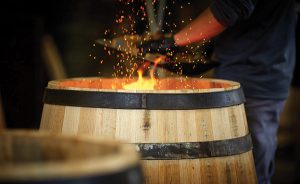
From lightly toasted wine casks to heavily charred bourbon barrels, the first substance to touch the inside of a new barrel is fire.
And for as long as people have been aging wine, whiskey, or other spirits in barrels, there have always been those who, upon pouring that last dram, ponder the empty cask and wonder, “Well, what should we do with it now?” Perhaps no one has pondered it more in recent decades than craft brewers.
In the mid-1990s Greg Hall, who was brewing beer at the still small Goose Island Brewpub in Chicago, came up with an idea to celebrate the brewery’s thousandth batch of beer. He would brew a stout, he decided, then age it in bourbon barrels.
Taylor Smack, who entered the craft beer scene as head brewer at Goose Island’s original location a few years after Hall’s groundbreaking stout, tells the story: “Aging beer in wood barrels is as old as the hills. Traditionally, however, brewers went through great care to have no flavor impact from the barrel – pitch-lining them, steam cleaning them, etc. Greg Hall’s innovation to age beer in barrels with the intent to incorporate the flavors from what was previously in the barrels was new.” The result of that innovation was the much heralded, limited release Bourbon County Stout.
From there, other brewers in the Illinois Craft Brewers Guild began trying their hands at the aging-in-used-spirits-barrels technique, too. “That was really how it spread, from Goose Island to the neighboring breweries; after that it was like a match in a dry hay pile,” Smack said. “It was cool to see it happen.”
Smack brought the technique to Charlottesville’s South Street Brewing in 2002 with great success. “My mentor Jacque Landry and I actually placed first in the Experimental Category at the first ever Festival of Barrel Aged Beer in Chicago,” Smack said. “We beat out Sam Adams’ Utopias…that was pretty exciting.”
He went on to co-found Blue Mountain Brewery (which later purchased South Street) where he is currently co-owner and brewmaster. There in the hills of Nelson County, tapping ample cold, clean, perfect brewing water from wells nearly 500 feet deep, Smack created Dark Hollow, a low-roast, barrel-aged, imperial stout with notes of bourbon and vanilla. It became Blue Mountain’s flagship beer and was so popular they expanded their operation. The Barrel House was constructed a half-hour south of the main brewery, and was equipped with a special brewing system that gives them better control of the 10% ABV Dark Hollow and their other higher gravity beers.
The barrel-aging room can hold up to 600 barrels in a temperature-controlled climate, fluctuating the temperature along a 26-degree Fahrenheit range every three weeks to help move the beer in and out of the porous char of the whiskey barrels. “There are a few other things that make the process special,” Smack said. “But a gentleman has to have some secrets.”
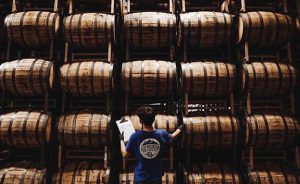
James Critz inspects beer-filled barrels aging at Blue Mountain Barrel House.
For bourbon and most other American whiskey production, barrels are required to be three things: new, American, and charred. After that one use, distillers have empty barrels they can’t use. Well, “empty” isn’t exactly accurate. Many gallons of whiskey remains soaked into the wood. Blue Mountain sources most of the whiskey barrels they use for aging from numerous distilleries in Kentucky. A few hours north in Loudoun County, Catoctin Creek Distilling Company finds their used whisky barrels (Catoctin Creek uses the traditional Scottish spelling of whisky without the “e”) in high demand locally and beyond, and not just from breweries.
“Sharing barrels sprang out of necessity,” Catoctin Creek owner Scott Harris said. “There are only so many barrels, it would be a shame to waste something with that level of craftsmanship when it could get much, much more use.” Their first collaboration was with maple syrup maker Langdon Wood, who uses Catoctin Creek’s rye and brandy barrels for their syrups.
“The rye brings this amazing vanilla and oak flavor and a little spiciness to the syrup that even people who say they don’t like rye tell us they love,” Art Drauglis, Langdon Wood’s “Syrup Baron” said. “The brandy barrel-aged syrup (Brandy Time) is like boozy brunch in a bottle.” Art and his wife Ketzirah have long thought of taking reaction photos to capture the faces of customers tasting the syrups for the first time. “Sometimes they are skeptical, but then they just smile and go, ‘Wow!’” Art said.
At first, that barrel-aged syrup was the end of that collaboration. But Harris soon saw the great unrealized potential of the multi-use barrel. While his 100% rye whisky is required to be manufactured in new barrels, he could age existing whisky in those barrels now infused with delicious maple syrup, and others with hickory syrup from Clarke County’s Falling Bark Farm. Those barrels of syrup-finished rye are now bottled and released once a year in the fall and are extremely popular.
Art and Ketzirah Drauglis keep a bottle of maple finished rye at their home and love it. “It brings a new sweetness and just a hint of maple to their fabulous rye,” Art said. “It’s great straight with a single ice cube, or mixed in cocktails.”
Adroit Theory Brewing Company in Purcellville specializes in “esoteric beers with an emphasis on barrel aging.” So naturally they are at the center of some fun collaborations. For instance, Adroit Theory brewed an imperial stout, which Catoctin Creek then distilled into a malt whisky. It was aged for 4.666 years and bottled as the Dia de los Muertos. It sold out almost immediately, but Langdon Wood then used that malt whisky barrel to age their maple syrup. The resulting Dia de Los Muertos whiskey barrel aged syrup was released this fall. In the words of Art the Syrup Baron, and perhaps a surprise to no one, “It’s pretty intense.”
Another dimension of creative barrel sharing occurs around the winemaking industry. Wine barrels differ from whiskey barrels cosmetically – the wood in wine barrels is kiln dried and toasted rather than charred, the sides of wine barrels are more round, the metal hoops are galvanized, and generally more care is taken in making them more attractive – but when a wine barrel gets emptied, people still want to put other things in it. And conversely, plenty of wine has spent time in whiskey barrels.
“We started our winery carrying on a tradition of aging one of our wines in once-used bourbon barrels,” Jay Decianno of Quattro Goombas Winery said. “This was something my grandfather and others had done when making wine for themselves.” Quattro Goombas ages their big red wines in barrels sourced from A. Smith Bowman, maker of Virginia Gentleman bourbon. There is also a craft brewery on the premises where beer has aged in both bourbon and wine barrels.
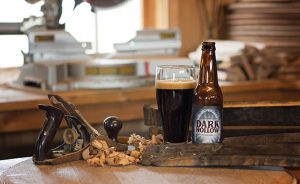
Blue Mountain Brewery’s flagship whiskey barrel-aged beer,
Dark Hollow, on the workbench at Jumbo Bottom Barrel Works.
Doug Fabbioli of Fabbioli Cellars in Loudoun County started his career at Buena Vista Winery in Sonoma, Calif., as the ‘Barrel Enologist,’ focusing on the barrel end of the business. As such, any filling, emptying, sampling, buying and selling of barrels – upwards of 8,000 of them each year – all happened under his domain. When he moved to Virginia, he used his extensive experience and California contacts for barrels to help Virginia startup wineries. He launched his first Fabbioli Cellars vintage in 2004 and opened the tasting room two years later. At any given time, he has roughly 150 barrels on site.
Fabbioli reuses barrels but tracks them carefully, because each time wine is aged, that barrel loses some of its capacity to impart oak character into the wine. The contents of different aged barrels may then be combined to produce a consistent wine from bottle to bottle. Blended wines typically also spend time together in a barrel to marry the flavors of different grapes, rather than trusting it will happen in the bottle. “A wedding is a moment,” Fabbioli says of aging blended wines together in barrels. “A marriage is time.”
Eventually, though, the barrels simply don’t have enough oak character to give, and Fabbioli retires between 30 and 40 barrels a year. These retired wine barrels are desirable to any number of brewers, distillers or other businesses hoping to capture the essence of the barrels’ previous inhabitant. But there’s a catch: once a wine barrel is emptied, the remaining wine, exposed to all the oxygen an empty barrel is now filled with, goes bad quickly. It’s important that the new resident of the barrel move in swiftly, so the retired Fabbioli barrels go mostly to local breweries and distilleries. Old Ox Brewery has aged beer in their raspberry barrels, Vanish Brewery right up the road from Fabbioli takes his cabernet sauvignon barrels. And any barrels used for big reds, fruit based wine, or ports are extremely sought after. Brandies, cordials, rum, etc. all can be aged in wine barrels, giving them all an additional dimension of creativity.
Fabbioli sees the rural economy as a rich, 3D tapestry. “By integrating byproducts and collaborating on side projects, we can be creative with our products,” he said. “We want to be more than, ‘This is it, this is all we do.’”
Examples of that collaborative creativity in Virginia abound. Sperryville’s Copper Fox Distillery sent barrels to King of Clubs Brewing – coffee, not beer – in Williamsburg to produce barrel-aged coffee beans. Virginia Distillery is producing cider-finished, port-finished, and coffee-finished whiskey. Industry partners are joining with restaurants, inventing products, sharing ideas, and swapping barrels. Tarver King, chef at The Restaurant at Patowmack Farm, not only barrel ages sugar, hot sauce, and other products he then uses in cooking, he uses barrel staves for grilling, smoking, plating creative dishes, and even aging cocktails.
In the spring of 2015, woodworker John Bestwick, living and working in the heart of Virginia’s wine country, purchased some wine barrels from Breaux Vineyards. He didn’t have a particular plan in mind for them, the idea was to just take them apart, assess the wood, and determine what could be made with the pieces.
- The end of a barrel’s usefulness as a vessel can sometimes mean the beginning of a new life as something else. Woodworker John Bestwick of family-owned Jumbo Bottom Barrel Works creates unique, eco-friendly furnishings from reclaimed barrels.
“The first thing I ever built was an Adirondack style chair,” Bestwick said. “I knew right then I was on to something I could sell.” His design took advantage of the curved staves and resulted in a uniquely beautiful, extraordinarily comfortable piece of furniture. He started Jumbo Bottom Barrel Works and now produces tables, bar stools, benches and more. But the chairs, largely unchanged from that first design, remain among his most popular pieces.
At his standalone workshop, surrounded by pieces of barrels that are finally no longer barrels, Bestwick feeds a few scraps of whiskey staves to a small wood stove. Then he opens a Blue Mountain barrel-aged Dark Hollow stout – with a barrel stave bottle opener, of course. He loves the beer, and appreciates the barrel that gave it its flavor, its character, and its punch. He holds it up to the light and, naturally, starts talking about barrels.
“Ever since I started doing this, I notice barrels everywhere – movies, commercials, TV shows, even cartoons,” Bestwick said. “I’m always yelling, ‘Look at that barrel!’” A few local wineries offer Barrel Club memberships, wherein members get to keep a barrel that was used to age a favorite wine. Some members have brought their barrels to Bestwick to have a custom piece of furniture created from it, adding even more layers of significance to the piece.
A barrel begins its lifespan filled only with fire. It passes from cooper to distiller or winemaker, then perhaps back and forth to brewers of beer or coffee, on to artists, craftsmen or chefs. It may end up as furniture on a front porch, a prop on a movie set, or scraps in a wood stove. Whatever its journey, thanks to the creativity and collaboration of all those who come to possess it, countless people will have shared in its essence along the way. And the barrel, with its simple construction and ancient design, becomes far greater than the sum of its parts.
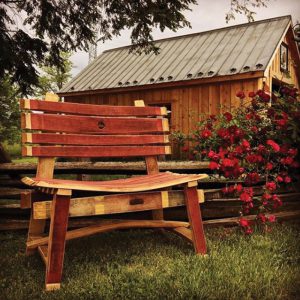

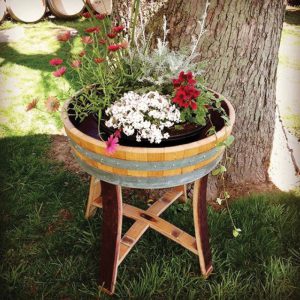
Leave a Reply